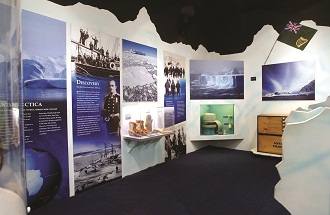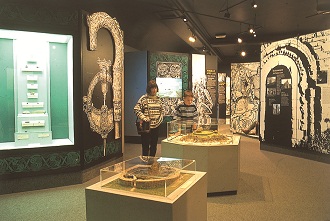
Kerry County Museum is situated in Tralee, Co Kerry in the south west of Ireland. In 2009 the Museum was awarded Irish Museum of the Year by the Heritage Council of Ireland and the Northern Ireland Museums Council. It was developed in 1991 as an initiative of Tralee Town Council, and housed in the Ashe Memorial Hall, previously the headquarters of local government in the town.
It was developed in two phases between 1991 and 1992. The Medieval Experience was opened in 1991 in the lower ground floor of the Ashe Hall. This was a ls"dark ride' experience, taking visitors by ls"time cars' through the recreated medieval town, with the sights, sounds and smells. In 1992 the permanent gallery of the Museum was opened, displaying the archaeology and history of the County. Thereafter, a temporary exhibition space was added, allowing for the development of major exhibitions. Today, the whole facility comprises 1,887 square metres, which includes the permanent gallery, exhibition space, Medieval Experience, reception, collections store, gift shop, tourist information, and cafeacute;. The Museum quickly established itself as a flagship visitor attraction in the southwest, consistently attracting over 90,000 visitors throughout the 1990s. Situated in an area of high tourist activity, the Museum developed an active approach to marketing and promotion. The Museum targeted all of the major tour operators, and throughout the 1990s the coach tour business contributed heavily to the total visitor figures.
A policy of large-scale blockbuster exhibitions was developed, all high-profile and with objects loaned from major institutions at home and abroad. One of the major benefits of these blockbuster exhibitions (besides increased visitor numbers) was that the Museum became confident in approaching major topics and entering into loan agreements with a variety of different institutions. This has left a very positive legacy of an outward-looking, can-do attitude. At the same time, however, issues have arisen over the years that have to be acknowledged. An inherent problem was that the Museum was developed in some ways as an after-thought to the Medieval Experience. The popularity of the Medieval Experience in the early years meant that all of the energy was directed towards sustaining that success. The whole facility was seen solely in terms of a tourist attraction, and the role of the Museum was under-developed. There were few resources given to any of the core museum functions such as education, access, collections, research. The curator was the only museum professional, and the majority of the staff was concerned with front-of-house.
The lack of development of the Museum was masked because of the successes of the Medieval Experience and the large scale exhibitions. Once the Medieval Experience reached a point of natural obsolescence, however, cracks began to show. This was exacerbated by the problems of the global tourism market from 2001 onwards, and coincided with a period of serious financial constraint within Tralee Town Council. With no money for re-investment, the ls"time cars' reached the end of the road in 2002 and the Medieval Experience was transformed into a walk-through rather than a ls"dark ride'.

This, however, was as much an opportunity as it was a crisis. It was now obvious that there had been an over-reliance on the Medieval Experience to the detriment of the Museum. Part of the solution, therefore, was to develop the Museum's potential. It was clear that the Museum needed to develop its core functions and to build a year-round local audience to insulate it from the vagaries of international tourism. In 2005 a second museum professional was employed and in 2007 the opportunity arose to formalise and establish the roles of Collections Officer and Education Officer. This was a significant step in the development of the Museum's core functions.
We have spent the past few years changing the emphasis from the quantity of visits to the quality of the visit. One of the main drivers in this change of emphasis is the provision of education services. We have developed a dynamic education programme to encourage schools to use the Museum as a resource during the course of the school year. At the same time, an outreach programme of workshops, lectures and events has encouraged the local community to see the Museum as theirs. An important step was the Museum's acceptance into the Museum Standards Programme for Ireland, run by the Heritage Council. Working towards accreditation under that programme has brought a vast improvement in our collections care and documentation, which allows us to communicate more effectively with our audience. We have continued the policy of high profile exhibitions, but now with a more definable Kerry twist to them.
Our Museum is now nearly 20 years old, and some things in it are perhaps not so shiny as they once were, but overall it is as vibrant and dynamic as if it opened yesterday, and this is why it is Ireland's Museum of the Year.